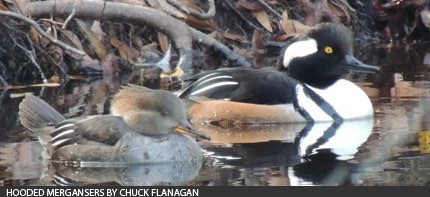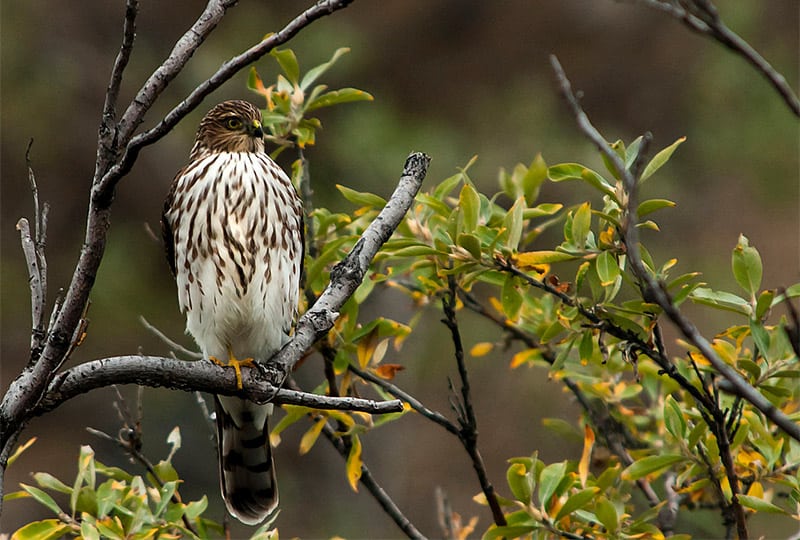In his foreword to A Sand County Almanac, Aldo Leopold wrote these familiar words: “There are some who can live without wild things, and some who cannot.” This guide to Wisconsin bird watching is for those who cannot: Those who cannot lie in bed on an early May morning knowing that scarlet tanagers may have arrived in a nearby Wisconsin woodlot the night before. Those who cannot stay by a warm winter fire knowing that, just an hour away, bald eagles are congregating along the Wisconsin River. Those who cannot drive by a flooded farm field without stopping, or at least slowing down, knowing that shorebirds may be foraging along the muddy edges. And those who cannot seem to shake the bird watching bug.
Fortunately for those of us “afflicted,” Wisconsin offers a wealth of wild things bearing feathers, boasting a bird list with 422 species. Roughly half take up residence, showing up on Breeding Bird Surveys conducted in the state. Because Wisconsin is uniquely bordered by two major waterways—the Mississippi River and the Great Lakes—others pass through on their way to and from their breeding grounds. And, because three vegetational zones (southeastern deciduous forests, northern coniferous forests, and dry grasslands) converge in Wisconsin, we often see species more common to the North, South, and West. Some of us who caught the birding bug years ago have added infrequent visitors such as orchard oriole and Carolina wren to our life lists, experiencing the thrill of the unexpected. For new watchers of wild things, that excitement awaits.
Much of Aldo Leopold’s inspiration for A Sand County Almanac came while living in a rickety shack in central Wisconsin, the only chicken coop listed on the National Register of Historic Places. At the time, Wisconsin was at the forefront of an environmental movement that would change how we think about wildlife—including birds—irrevocably. A founder of The Wilderness Society, Leopold moved to Madison in 1933 to chair the new Department of Wildlife Management for the University of Wisconsin. Considered by many to be the father of wildlife ecology, Leopold outlined the techniques needed to effectively manage and restore wildlife populations. He believed the same tools people used to disrupt the landscape could be used to rebuild it, and his work and writings helped develop a land ethic that endures today.
Years earlier, naturalist John Muir wrote about his boyhood in Wisconsin, extolling the wild landscape he observed: “Oh, that glorious Wisconsin wilderness! Everything new and pure in the very prime of the spring when Nature’s pulses were beating highest and mysteriously keeping time with our own!” The Muir family emigrated from Scotland in 1849, settling on a farm near Portage in central Wisconsin. Muir lived in the state until 1863, becoming a keen observer of the natural world and developing a land ethic of his own. His later peregrinations led him to Central America and the West Coast, where he was instrumental in the establishment of Yosemite National Park.
Muir and Leopold are just two of the many visionaries who have fostered an appreciation of the rich wildlife resources in Wisconsin, a state that takes pride in its long progressive tradition and great natural beauty. It is home to the Gaylord Nelson Institute for Environmental Studies, named after the former U.S. senator from Wisconsin who founded Earth Day. It is home to the International Crane Foundation, established in 1973 to create a “species bank” for the world’s cranes through an innovative captive breeding program. And it is home to one of only two migratory flocks of whooping cranes, a species reintroduced to the state after an absence of more than a century.
When biologists George Archibald and Ron Sauey founded the International Crane Foundation on a former horse farm near Baraboo, little was known about the breeding biology of the world’s fifteen species of cranes. In the three decades since, the organization’s work has taken on a global focus as ICF biologists collaborate with colleagues around the world on research projects and captive breeding programs.
Bird watchers in Wisconsin can see the results of the foundation’s conservation efforts close to home by touring the ICF facility—and, for the lucky few, by looking skyward and seeing magnificent whooping cranes in flight. In 1999, the ICF joined the Whooping Crane Eastern Partnership, a group working to reintroduce a migratory flock of whooping cranes into their historic range in the eastern United States. Two years later, eight whooper chicks conditioned at the Necedah National Wildlife Refuge left the state, trailing an ultralight aircraft; seven of the birds made the 1,200-mile trip to Florida safely. After wintering in Florida at the Chassohowitzka National Wildlife Refuge, five young cranes returned to Wisconsin the next spring, this time flying without the guiding ultralight. As of 2004, fifty whoopers populate this migratory flock. (To track their travels or learn more about the project, check out www.savingcranes.org.)
The whooping crane reintroduction project is just one of numerous avian success stories in the state. Trumpeter swans were reintroduced to Wisconsin in 1987; approximately 400 trumpeters were released during the next decade, birds raised from eggs collected in Alaska. Current estimates put the trumpeter swan population in Wisconsin at about 300 birds.
Peregrine falcons, absent from the state for more than twenty years due in large part to the effects of pesticides such as DDT, can now be been in several Wisconsin locations. Through the release of birds raised in captive breeding programs, pairs have successfully nested on tall buildings in Milwaukee and Green Bay.
Ospreys, placed on the state’s Endangered Species List in 1972, are now seen with regularity over Wisconsin’s lakes, mostly in the northern part of the state. The construction of artificial nest platforms has helped the fish-eating species recover.
Wild turkeys, native to southern Wisconsin and an important food source for the state’s settlers and Native Americans, fell victim to habitat destruction in the late nineteenth century. Unregulated hunting also took its toll. By 1881, wild turkeys were extirpated in Wisconsin. Nearly a century later, the Department of Natural Resources released twenty-nine turkeys, birds obtained from Missouri, in Vernon County. Today, wild turkeys are found in the southern two-thirds of the state, with an estimated population of more than 200,000 birds.
Sandhill cranes, once hunted to near extinction, benefited from habitat restoration projects around the state and can now be seen by the thousands in several Wisconsin staging areas. And eastern bluebirds, a species once in dangerous decline, are thriving due to the efforts of the Bluebird Restoration Association of Wisconsin, with reported fledging of 13,000 bluebirds in 2004.
Each success story is the result of extensive research, involving countless hours in the field and the cooperation of many agencies and organizations. And the work is clearly not done. Twelve species remain on the state’s list of endangered birds, with another thirteen classified as threatened. An additional fifty-seven are listed as “Special Concern” species and are being monitored for any significant population changes.
The Wisconsin Society for Ornithology (WSO) has been watching populations of Wisconsin birds for almost seventy years. Founded in 1939 to encourage the study of birds throughout the state, the organization’s goals have expanded to encourage many aspects of bird watching and to support the research and habitat protection needed to preserve Wisconsin birdlife. The WSO has a diverse membership, from professional ornithologists to those who mostly bird watch in their backyards. The group publishes a quarterly journal, The Passenger Pigeon, which features seasonal field sightings, Christmas and Big Day counts, and scientific research reports. A newsletter keeps members informed of the group’s field trips and other events. The WSO recently completed a five-year Wisconsin Breeding Bird Atlas, designed to provide a record of bird species breeding in the state and baseline data to monitor changes in bird populations.
A recent collaboration involving the Wisconsin Department of Natural Resources’s Bureau of Endangered Resources, the WSO, and more than one hundred other agencies and groups will put Wisconsin bird watching on the map—literally. The Wisconsin Bird Conservation Initiative is developing a statewide highway-based trail that will showcase some of the best bird watching opportunities in the state. When completed in 2008, the Great Wisconsin Birding and Nature Trail will include five regional segments with unique ecological features, with release of one full-color viewing guide a year. The seventy-two-page Lake Superior/North Woods guide was released in 2004; the other guides, in order of their publication dates, are Mississippi/Chippewa Rivers, Lake Michigan, Central Sands Prairie, and Southern Savanna. The Wisconsin Department of Tourism is designing and printing the guides using information compiled by the Department of Natural Resources (DNR).
The Great Wisconsin Birding and Nature Trail is just one of many ways to enjoy bird watching in Wisconsin. Some of the best birding, of course, can be done in your own backyard, in the city park near your office, or in any number of unexpected places. I saw my first snowy owl perched atop the building where I worked in downtown Milwaukee, my first peregrine falcon while walking around the Capitol Square in Madison, my first white-winged crossbill while driving home from a dental appointment, and my first (and only!) worm-eating warbler while enjoying spring wildflowers in a small city preserve near my home.
So welcome to Wisconsin bird watching—and enjoy all the wild things the Badger State has to offer!



